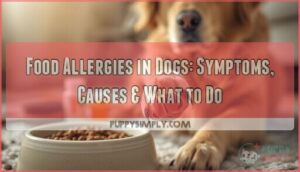This site is supported by our readers. We may earn a commission, at no cost to you, if you purchase through links.
Your dog’s constant scratching might not be fleas. When a previously calm pup suddenly develops itchy paws, ear infections that won’t quit, or digestive issues that seem to come out of nowhere, you’re likely watching their immune system wage war against something in their food bowl.
Food allergies in dogs often mimic other conditions, which is why many owners spend months treating the wrong problem. The immune response targets proteins they’ve eaten safely for years, turning mealtime into a trigger for inflammation throughout their body.
Recognizing the specific patterns of allergic reactions—from the red, irritated skin between their toes to changes in stool consistency—gives you the information you need to help your dog find relief.
Table Of Contents
- Key Takeaways
- What Are Food Allergies in Dogs?
- Common Causes of Food Allergies
- Key Symptoms of Food Allergies
- Skin and Coat Signs to Watch For
- Digestive Symptoms in Allergic Dogs
- Behavioral Changes Linked to Allergies
- How Food Allergies Are Diagnosed
- Managing and Treating Food Allergies
- Frequently Asked Questions (FAQs)
- What is the most common food allergy in dogs?
- How do you know if your dog is allergic to their food?
- How quickly do dogs react to food allergies?
- What can I give my dog with food allergies?
- Can puppies develop food allergies?
- Which breeds are most prone to food allergies?
- Are food allergies in dogs hereditary?
- Can food allergies cause behavior changes in dogs?
- How soon do symptoms appear after eating an allergen?
- Can puppies develop food allergies early in life?
- Conclusion
Key Takeaways
- Food allergies in dogs are immune-mediated reactions to dietary proteins (most commonly beef, dairy, chicken, and wheat) that develop after repeated exposure and affect multiple body systems simultaneously—not just the skin.
- The only reliable diagnostic method is an 8-12 week elimination diet trial with a novel or hydrolyzed protein source, since blood and saliva tests lack clinical validation and produce false positives in up to 42% of cases.
- Symptoms extend beyond itchy skin to include chronic ear infections (affecting nearly half of allergic dogs), gastrointestinal issues like diarrhea and vomiting (in 30% of cases), and behavioral changes including irritability, lethargy, or hyperactivity linked to inflammation and discomfort.
- Lifelong management requires strict allergen avoidance through hydrolyzed or novel protein diets, with most dogs experiencing symptom relapse within 4-8 days of re-exposure to their trigger ingredient.
What Are Food Allergies in Dogs?
Food allergies in dogs work much like they do in people—your dog’s immune system reacts to certain ingredients in their diet, usually proteins. But not all food reactions are true allergies, and understanding the difference matters when treatment is involved.
Let’s break down what’s actually happening inside your dog’s body when food becomes the problem.
Definition and Overview
Food allergy in dogs happens when your pet’s immune system mistakenly treats certain food proteins as threats, triggering immune-mediated reactions. This condition, also known as CAFR symptoms, develops after prolonged exposure to specific ingredients. Understanding what causes food allergies helps you recognize when antibody production kicks in:
- Food allergies rank among common hypersensitivities in dogs
- Reactions require repeated exposure to develop fully
- Proteins trigger most allergic responses
- Gastrointestinal and skin symptoms often appear together
- Different from simple food intolerance, which doesn’t involve immunity
Diagnosing food allergies in dogs requires careful observation and testing. These reactions are often due to IgE-mediated hypersensitivity.
Difference Between Allergy and Intolerance
While both food allergy and food intolerance affect your dog, they work differently. A food allergy involves an immune response with IgE antibodies attacking specific proteins, requiring prior exposure. Food intolerance symptoms in dogs skip the immune system entirely—think of it like lactose intolerance in people.
Symptom onset differs too: intolerances strike within hours, while allergic reactions may take days to appear. More information can be found at Dogs First’s website regarding these differences.
Immune System Involvement
When your dog’s immune system mistakenly identifies food proteins as threats, it launches complex defense mechanisms. T-cell immunity and IgE hypersensitivity work together—90% of allergic dogs show activated T cells, while IgE antibodies trigger immediate reactions. Cytokine profiles shift, increasing inflammatory signals, though Treg cells normally prevent overreaction. Your dog’s gut microbiome also shapes this response, influencing whether tolerance or allergy develops.
- T cells and IgE antibodies both drive allergic responses
- Cytokines heighten inflammation during reactions
- Gut bacteria influence immune tolerance development
Common Causes of Food Allergies
Not every dog develops food allergies, but certain factors make some more vulnerable than others. The ingredients in your dog’s bowl, their breed, and their genetic background all play a role in whether they’ll react to their food.
Understanding these common causes can help you recognize potential risks and make informed choices for your dog’s diet.
Typical Allergenic Ingredients
Think of your dog’s bowl as a potential minefield. The most common food allergens are animal proteins—beef tops the list at 34%, followed by dairy at 17% and chicken at 15%. Wheat causes reactions in 13% of allergic dogs.
Watch out for hidden allergens too, like “meat by-products” or “natural flavors,” which often contain these proteins without clear labeling.
Breed Predisposition
Your pup’s pedigree might hold clues to their food sensitivities. Genetic factors play a role, with certain dog breeds showing a higher prevalence of food allergies, particularly among Western breeds:
- German Shepherd dogs and Labrador Retrievers consistently top the list
- West Highland White Terriers and French Bulldogs show elevated risk
- Toy Poodles account for nearly 15% of cases in some studies
- Golden Retrievers and Boxers also appear more frequently
This diagnostic impact means vets often suspect allergies earlier in these breeds, especially with early-onset symptoms.
Inherited Risk Factors
While breed predispositions set the stage, a deeper genetic component drives food allergies. Genetic markers in immune system regions can explain 50 to 80% of your dog’s allergy risk.
Family history matters too—dogs with affected relatives face considerably higher odds. However, polygenic inheritance makes prediction complex, as multiple genes interact with diet and environment to determine whether allergies actually develop.
Key Symptoms of Food Allergies
When your dog has a food allergy, the symptoms can show up in different parts of the body, and they don’t always look the same from one dog to another. Some dogs develop stomach issues that are hard to miss, while others might seem restless or just not quite themselves.
Recognizing these signs early helps you connect the dots and get your dog the relief they need.
Gastrointestinal Symptoms
When your pet’s stomach rebels after mealtime, it might be more than a passing bug. Gastrointestinal signs like diarrhea and vomiting affect up to 30% of dogs with food allergies. You’ll notice increased defecation frequency, excessive gas production, and occasional abdominal discomfort.
These digestive problems can lead to weight changes if they persist, though symptoms generally improve within weeks once you eliminate the offending allergen.
Behavioral and Energy Changes
Food allergies can throw your dog’s energy and mood off balance. Nearly half of allergic dogs show lethargy signs during flare-ups, while others swing toward restless hyperactivity.
Watch for these dog behavior changes:
- Irritability triggers and aggression (37% of cases)
- Anxiety symptoms like pacing or excessive panting
- Sleep disruption affecting 38% of allergic dogs
- Fluctuating energy levels alternating between hyperactivity and lethargy
These shifts often improve once you identify the allergen.
Skin and Coat Signs to Watch For
When your dog has a food allergy, their skin often tells the story first. You might notice changes in their coat, unusual scratching, or infections that keep coming back.
Here are the most common skin and coat signs that point to a possible food allergy.
Itchy and Red Skin
Itchy, red skin is the most common sign of food allergies in dogs, affecting up to 40% of cases. You’ll often notice skin irritation on your dog’s feet, belly, face, and around the ears.
These skin signs result from an immune response to dietary proteins, with breed susceptibility varying among certain lines.
Diet impact is significant—elimination trials resolve itching in 78–90% of dogs, confirming allergy correlations and addressing underlying risk factors.
Hair Loss and Licking
When your dog constantly licks their paws, face, or belly, you’re seeing both a symptom and a cause of hair loss. That repetitive licking creates bald patches and brown-stained fur from saliva pigments—clear diagnostic observations of food allergies.
About 31% of food-allergic dogs develop hair loss from this self-trauma, often leading to secondary infections that worsen the skin irritation and itching cycle.
Ear and Skin Infections
That persistent licking often opens the door to secondary infections—and they’re more common than you might think. Up to 80% of food-allergic dogs develop ear infections at some point, while chronic skin conditions frequently follow. Here’s what breed predisposition and microbiome impact mean for infection risk:
- Bacterial overgrowth (especially Staphylococcus) thrives on inflamed, allergic skin
- Yeast infections commonly appear in predisposed breeds
- Chronic infections signal immune response problems tied to food allergens
Digestive Symptoms in Allergic Dogs
While itchy skin gets most of the attention, your dog’s digestive system often tells an equally important story when food allergies strike.
Gastrointestinal symptoms can range from mild discomfort to more serious signs that disrupt your dog’s daily life. Here’s what to watch for in your dog’s digestive health.
Diarrhea and Vomiting
While skin issues steal the spotlight, gastrointestinal upset affects roughly 30% of food-allergic dogs. You might notice chronic diarrhea that ranges from soft stools to watery consistency, sometimes with blood or mucus during allergy flares. Acute vomiting can happen hours after eating the offending protein.
Most digestive problems improve within 4-12 weeks on an elimination diet, though symptom relapse occurs quickly if your dog encounters the allergen again.
Gas and Bloating
Beyond diarrhea and vomiting, you might notice your dog experiencing excessive gas or visible bloating—classic gastrointestinal issues that point to digestive upset in the canine digestive tract. Dietary triggers like soy, grains, or dairy proteins spark gut fermentation, especially if your dog has lactose intolerance or enzyme deficiencies.
Watch for:
- Abdominal distension after meals
- Foul-smelling flatulence
- Discomfort or restlessness
Symptom monitoring helps pinpoint the culprit ingredient during elimination trials.
Appetite Loss and Weight Loss
When gas and bloating persist, chronic diarrhea often follows—and that’s where appetite loss and weight loss enter the picture. About 30% of food-allergic dogs show digestive problems affecting mealtime behavior and body condition. Poor nutrient absorption from ongoing inflammation means your dog might shed pounds even while eating normally. Successful intervention outcomes depend on identifying food allergy symptoms in dogs early, before weight loss becomes severe.
| Symptom | What You’ll Notice |
|---|---|
| Appetite changes | Intermittent food refusal, reduced interest at meals |
| Weight decline | Gradual loss despite normal portions |
| Malnutrition signs | Poor coat, low energy, visible ribs |
| GI complications | Soft stools, vomiting alongside weight drop |
Behavioral Changes Linked to Allergies
Food allergies don’t just affect your dog’s skin or stomach—they can change how your dog acts and feels. You might notice sudden shifts in energy, mood, or behavior that seem out of character.
Here’s what to watch for when allergies start affecting your dog’s behavior.
Hyperactivity
Some dogs with food allergies can seem like they’ve had too much coffee—suddenly restless, pacing, or unusually wired. Hyperactivity shows up in roughly 20–30% of dogs with food sensitivities, especially after eating meals with dietary triggers. You might notice:
- Increased pacing or jumping after eating
- Difficulty settling down or resting
- Higher scores on behavioral scales used in veterinary assessments
Activity monitoring helps track these behavioral changes and their impact on quality of life.
Mood and Aggression Shifts
When food allergies trigger discomfort, they can also affect your dog’s mood and behavior. Up to 38% of allergic dogs show irritability or grumpiness, with beef, dairy, wheat, and chicken as common allergens. Anxiety symptoms appear in about 1 in 4 cases, while roughly 20% develop reactive behaviors or mild aggression. Studies link these behavioral problems to gut microbiome changes, with distinct bacterial patterns found in aggressive food-allergic dogs.
| Behavioral Change | Prevalence | Common Triggers |
|---|---|---|
| Allergy-induced irritability | Up to 38% | Beef, dairy, chicken |
| Anxiety symptoms | ~25% | Multiple allergens |
| Aggression/reactive behaviors | ~20% | Diet-related discomfort |
Impulse control issues—like food-stealing or excessive attention-seeking—increase by 60% during allergic episodes. The gut-brain axis may explain these mood changes, as inflammatory responses affect neurological function. Fortunately, 85% of dogs return to their normal temperament after eliminating the offending ingredient through an elimination diet, commonly within 2–8 weeks.
Allergic dogs show 60% more impulse control issues, but 85% return to normal temperament within weeks of eliminating the trigger ingredient
Lethargy and Decreased Energy
When inflammation from food allergies drains your dog’s vitality, you’ll notice decreased energy levels. Up to 24% of dogs at specialty clinics show lethargy alongside skin conditions. This lack of energy connects to the immune response and nutritional deficiency—affected dogs often eat less than 25% of their needed calories. Watch for these behavioral problems:
- Marked decline in daily activity level
- Reluctance to play or exercise
- Sleeping more than usual
- Slower recovery after walks
- Reduced interest in surroundings
Elimination diets improve symptoms of food allergies in 60% of cases within 8 weeks.
How Food Allergies Are Diagnosed
Figuring out if your dog has a food allergy isn’t as simple as running a quick test at the vet’s office. Your veterinarian will use a combination of careful observation, your dog’s medical history, and a specific feeding trial to pinpoint the problem.
Let’s look at the three main steps involved in getting an accurate diagnosis.
Physical Exam and Clinical Signs
When you bring your dog to the vet, expect a thorough physical exam focusing on skin, ears, and overall condition. Your vet will assess pruritus severity, look for skin lesions, and check for chronic ear infections—present in nearly half of food-allergic dogs. They’ll also note signs like hair loss, brown paw staining, and any gastrointestinal distress. Understanding clinical signs helps pinpoint food allergies.
| Body Area | Common Clinical Signs | Frequency in Allergic Dogs |
|---|---|---|
| Skin | Itching, redness, hair loss | Over 95% show pruritus |
| Ears | Inflammation, infection, swelling | Up to 49% with chronic otitis |
| Digestive | Diarrhea, vomiting, abdominal pain | 10–15% with GI symptoms |
Elimination Diet Trial
The established method for diagnosing food allergies remains the elimination diet trial—a carefully controlled test where your dog eats only one novel protein and carbohydrate for 8 to 12 weeks. Here’s what you need to know:
- Trial Duration: Most dogs show improvement by five weeks, but full remission requires at least eight weeks.
- Success Rates: Around 50% improve by three weeks; 95% achieve remission by eight weeks.
- Diet Protocols: Feed only prescribed foods—no treats, table scraps, or flavored medications allowed.
- Response Measurement: Track symptom changes using pruritus scores and skin assessments throughout the trial.
- Outcome Variability: Less than 5% of dogs need trials extended to 13 weeks for complete resolution.
Strict compliance determines success; even tiny dietary exposures can invalidate results.
Limitations of Blood and Saliva Tests
Blood and saliva tests for diagnosing food allergies in dogs lack clinical validation and suffer from poor accuracy—ranging from 58% to 87%—with alarmingly high false positives. Test standardization remains inconsistent across laboratories, and these panels can’t reliably distinguish allergic from healthy dogs.
Beyond economic drawbacks (often exceeding $200), these tests rarely improve allergy diagnosis outcomes. Your veterinarian should rely on elimination trials, not unproven commercial panels.
Managing and Treating Food Allergies
Once you’ve confirmed your dog has a food allergy, the next step is working with your vet to create a treatment plan that keeps symptoms under control. Most management involves carefully adjusting your dog’s diet, though medications and supplements can also play a supporting role.
Here’s what you need to know about the main approaches to treating and managing food allergies.
Allergen Elimination Diets
Once you’ve confirmed a food allergy through an elimination diet trial lasting 8 weeks, maintaining strict dietary restrictions becomes your dog’s lifelong solution. You’ll need to feed either hydrolyzed protein diets, where proteins are broken down to reduce allergen potential, or novel protein diets featuring ingredients your dog hasn’t eaten before:
- Complete elimination of the offending allergen from all food sources
- Shift slowly over 5–7 days to prevent digestive upsets
- Avoid all treats, table scraps, and flavored medications during the food trial
Owner compliance directly determines success—even small breaks compromise results.
Medications and Supplements
When dietary changes alone don’t bring enough relief, medications and supplements can ease your dog’s discomfort. Options include monoclonal antibody therapy like lokivetmab, which reduced itching by 58% within 28 days in clinical trials, and Apoquel (oclacitinib), proven to lower pruritus scores from 7.58 cm to 2.59 cm on a 10-point scale within just one week.
| Treatment Type | How It Helps |
|---|---|
| Monoclonal antibody therapy (lokivetmab) | Blocks itch signals; 45.5% of dogs reached normal pruritus scores by day 28 |
| Janus kinase inhibitor (Apoquel) | Reduces inflammation rapidly; 74% achieved 50% pruritus reduction by day 14 |
| Omega-3 fatty acids (fish oil) | Reinforces skin barrier; shown steroid-sparing benefits in 12-week trials |
| Palmitoylethanolamide (PEA) | Modulates mast cells; 45% of dogs achieved quality of life comparable to healthy animals |
Omega-3 supplements, particularly fish oil with EPA and DHA, demonstrated steroid-sparing effects in controlled trials, letting dogs use lower prednisolone doses while maintaining symptom control. You’ll generally see improvements after several weeks of consistent supplementation.
Palmitoylethanolamide (PEA) offers another option with excellent tolerability—only four of 160 dogs experienced reversible side effects in an 8-week study. This anti-inflammatory compound reduced pruritus and improved quality of life scores considerably by day 56.
Probiotics show promise as adjuncts, though current evidence reveals modest improvements. A 2025 meta-analysis found probiotic-treated dogs had slightly lower lesion and pruritus scores at 12 weeks, supporting their use alongside—not instead of—primary treatments like allergen elimination diets and allergy medications for dogs.
Your veterinarian will tailor medication choices to your dog’s specific needs, balancing rapid symptom relief with long-term management goals for treating dog food allergies effectively.
Preventing Future Reactions
Once symptoms are under control, your focus shifts to keeping them away. Permanent allergen avoidance is your strongest defense—most dogs will react again within 4–8 days of re-exposure to their trigger food.
Here’s how to prevent recurrence:
- Dietary rotation – Vary protein sources every 2–4 weeks after identifying safe options
- Label scrutiny – Choose trusted brands; 27% of commercial foods contain undeclared proteins
- Early exposure – Household dogs may reduce allergy risk in developing animals by 90%
- Follow-up trials – Retest every 6–12 months to confirm tolerance
- Allergen avoidance – Stick strictly to hydrolyzed protein diet or elimination diet formulas
Detailed food diaries help you spot accidental exposures quickly, and regular veterinary check-ins reduce nutritional deficiency risk by 30% compared to self-managed plans.
Frequently Asked Questions (FAQs)
What is the most common food allergy in dogs?
Beef is the single most common food allergen in dogs, causing about 34% of all reactions. Dairy follows at 17%, then chicken at 15%, and wheat at 13%.
How do you know if your dog is allergic to their food?
Your dog’s persistent scratching, red inflamed ears, or frequent paw licking can signal a food allergy. Watch for chronic skin infections, facial swelling, or digestive upset—these symptoms often point to ingredient sensitivities requiring dietary investigation.
How quickly do dogs react to food allergies?
Immediate reactions can appear within minutes to hours, but most dogs show symptoms 1 to 5 days after eating the allergen.
About half develop signs by day five, with nearly all reacting within two weeks.
What can I give my dog with food allergies?
You can feed your dog hydrolyzed protein diets, novel protein sources like rabbit or kangaroo, or limited-ingredient prescription diets.
Hypoallergenic treats, safe homemade options with single proteins, and plant-based chews work well too.
Can puppies develop food allergies?
Yes, puppies can develop food allergies. Most symptoms appear between 6 months and 2 years of age.
Early onset occurs because their immune development makes them vulnerable to allergen exposure from proteins like beef, chicken, and dairy.
Which breeds are most prone to food allergies?
Certain purebreds carry a heavier burden with respect to food allergy risks. German Shepherds, Labrador Retrievers, West Highland White Terriers, and Golden Retrievers consistently show breed prevalence for canine allergies related to dietary proteins.
Are food allergies in dogs hereditary?
Food allergies in dogs show strong familial aggregation, with genetic markers and breed susceptibility playing significant roles.
Inheritance patterns involve multiple genes affecting immune system responses, though gene-environment interactions also influence whether canine allergies develop.
Can food allergies cause behavior changes in dogs?
Discomfort from allergic reactions can trigger mood shifts in your dog.
Between 15% and 20% of affected dogs show hyperactivity, aggression, or lethargy linked to inflammatory mediators, gastrointestinal upset, and gut-brain axis disruption.
How soon do symptoms appear after eating an allergen?
Symptoms generally appear within 2 to 4 hours after your dog eats an allergen, though skin signs like itching can start as early as 1 hour.
Digestive issues may take up to 24 hours to develop.
Can puppies develop food allergies early in life?
Yes, your little one’s immune development during weaning can make them vulnerable. Food allergies emerge in puppies as early as 10 weeks, often tied to genetic predisposition and gut microbiome health influenced by maternal diet.
Conclusion
Like a detective following clues to solve a case, you’ve now learned to recognize the signs your dog’s body sends when food becomes the enemy. From itchy paws to persistent digestive troubles, food allergies in dogs symptoms create patterns you can identify.
Armed with this knowledge and your veterinarian’s guidance, you’re equipped to transform your dog’s daily discomfort into lasting relief through careful diet management and appropriate treatment.
- https://www.purinainstitute.com/centresquare/therapeutic-nutrition/food-allergy-and-food-intolerance
- https://www.petfoodinstitute.org/pet-food-allergies/
- https://nutritionrvn.com/2024/08/25/food-allergy-guide/
- https://www.merckvetmanual.com/integumentary-system/food-allergy/cutaneous-food-allergy-in-animals
- https://www.petmd.com/dog/conditions/digestive/food-allergies-dogs
















